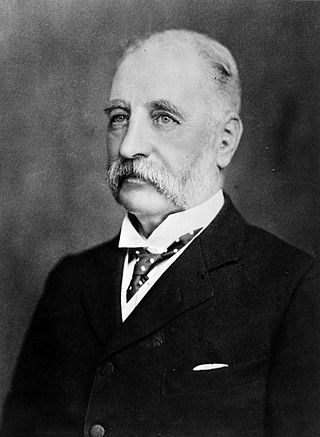
Sir James Hector was a Scottish-New Zealand geologist, naturalist, and surgeon who accompanied the Palliser Expedition as a surgeon and geologist. He went on to have a lengthy career as a government employed man of science in New Zealand, and during this period he dominated the Colony's scientific institutions in a way that no single man has since.
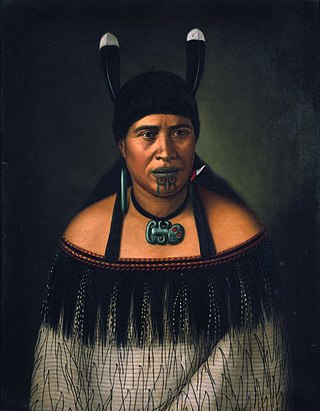
The hei-tiki is an ornamental pendant of the Māori of New Zealand. Hei-tiki are usually made of pounamu (greenstone), and are considered a taonga (treasure) by Māori. They are commonly called tiki by New Zealanders, a term that originally refers to large human figures carved in wood and to the small wooden carvings used to mark sacred places.

A taiaha is a traditional weapon of the Māori of New Zealand; a close-quarters staff weapon made from either wood or whalebone, and used for short, sharp strikes or stabbing thrusts with efficient footwork on the part of the wielder.

The Museum of New Zealand Te Papa Tongarewa is New Zealand's national museum and is located in Wellington. Usually known as Te Papa, it opened in 1998 after the merging of the National Museum of New Zealand and the National Art Gallery. An average of more than 1.5 million people visit every year, making it the 26th-most-visited art gallery in the world. Te Papa operates under a bicultural philosophy, and emphasises the living stories behind its cultural treasures.

The mere is a type of short, broad-bladed weapon in the shape of an enlarged tear drop. It was used to strike/jab an opponent in the body or the head, usually made from nephrite jade. A mere is one of the traditional, hand to hand, one-handed weapons of the indigenous Māori of New Zealand, and a symbol of chieftainship.

The upland moa was a species of moa endemic to New Zealand. It was a ratite, a grouping of flightless birds with no keel on the sternum. It was the last moa species to become extinct, vanishing in 1445 CE, and was predominantly found in alpine and sub-alpine environments.

A tewhatewha is a long-handled Māori club weapon shaped like an axe. Designed to be held in two hands, the weapon comes to a mata (point) at one end and a rapa at the other.
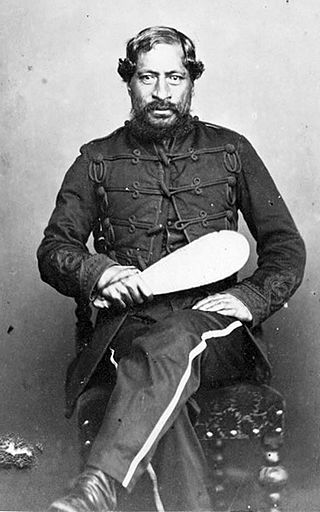
A patu is a club or pounder used by the Māori. The word patu in the Māori language means to strike, hit, beat, kill or subdue.

Kurī is the Māori name for the extinct Polynesian dog. It was introduced to New Zealand by the Polynesian ancestors of the Māori during their migration from East Polynesia in the 13th century AD. According to Māori tradition, the demigod Māui transformed his brother-in-law Irawaru into the first dog.

Māori traditional textiles are the indigenous textiles of the Māori people of New Zealand. The organisation Te Roopu Raranga Whatu o Aotearoa, the national Māori weavers' collective, aims to preserve and foster the skills of making and using these materials.

The ʻAhu ʻula, and the mahiole were symbols of the highest rank of the chiefly aliʻi class of ancient Hawaii. The feathered cloaks and capes provided physical protection, and were believed to provide spiritual protection for their wearers. There are over 160 examples of this traditional clothing in museums around the world. At least six of these cloaks were collected during the voyages of Captain Cook. These cloaks are made from a woven netting decorated with bird feathers and are examples of fine featherwork techniques. One of these cloaks was included in a painting of Cook's death by Johann Zoffany.
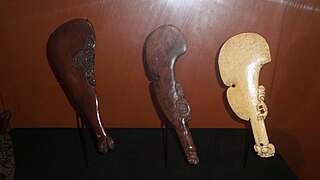
A Wahaika is a type of traditional Māori hand weapon. Wahaika are short club-like weapons usually made of wood or whalebone and are used for thrusting and striking in close-quarter, hand-to-hand fighting. Whalebone wahaika are called wahaika parāoa.
William OcklefordOldman was a British collector and dealer of ethnographic art and European arms and armour. His business W.O. Oldman, Ethnographical Specimens, London was mostly active between the late 1890s and 1913.

Hawaiian feather helmets, known as mahiole in the Hawaiian language, were worn with feather cloaks. These were symbols of the highest rank reserved for the men of the aliʻi, the chiefly class of Hawaii. There are examples of this traditional headgear in museums around the world. At least sixteen of these helmets were collected during the voyages of Captain Cook. These helmets are made from a woven frame structure decorated with bird feathers and are examples of fine featherwork techniques. One of these helmets was included in a painting of Cook's death by Johann Zoffany.

Pouwhenua or pou whenua, are carved wooden posts used by Māori, the indigenous peoples of New Zealand to mark territorial boundaries or places of significance. They are generally artistically and elaborately carved and can be found throughout New Zealand.
Jacqueline Fraser is a New Zealand artist of Ngāi Tahu descent.
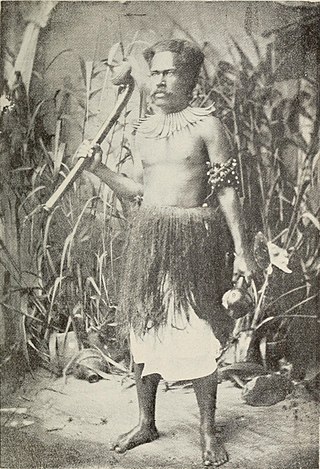
The totokia is a type of club or battlehammer from Fiji.
Marion Elizabeth Tylee was a New Zealand artist.

Pounamu is a term for several types of hard and durable stone found in southern New Zealand. They are highly valued in New Zealand, and carvings made from pounamu play an important role in Māori culture.

















